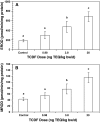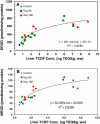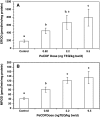Hepatic P450 enzyme activity, tissue morphology and histology of mink (Mustela vison) exposed to polychlorinated dibenzofurans
- PMID: 19458992
- PMCID: PMC2700875
- DOI: 10.1007/s00244-008-9241-3
Hepatic P450 enzyme activity, tissue morphology and histology of mink (Mustela vison) exposed to polychlorinated dibenzofurans
Abstract
Dose- and time-dependent effects of environmentally relevant concentrations of 2,3,7,8-tetrachlorodibenzo-p-dioxin equivalents (TEQ) of 2,3,7,8-tetrachlorodibenzofuran (TCDF), 2,3,4,7,8-pentachlorodibenzofuran (PeCDF), or a mixture of these two congeners on hepatic P450 enzyme activity and tissue morphology, including jaw histology, of adult ranch mink were determined under controlled conditions. Adult female ranch mink were fed either TCDF (0.98, 3.8, or 20 ng TEQ(TCDF)/kg bw/day) or PeCDF (0.62, 2.2, or 9.5 ng TEQ(PeCDF)/kg bw/day), or a mixture of TCDF and PeCDF (4.1 ng TEQ(TCDF)/kg bw/day and 2.8 ng TEQ(PeCDF)/kg bw/day, respectively) for 180 days. Doses used in this study were approximately eight times greater than those reported in a parallel field study. Activities of the cytochrome P450 1A enzymes, ethoxyresorufin O-deethylase (EROD) and methoxyresorufin O-deethylase (MROD) were significantly greater in livers of mink exposed to TCDF, PeCDF, and a mixture of the two congeners; however, there were no significant histological or morphological effects observed. It was determined that EROD and MROD activity can be used as sensitive biomarkers of exposure to PeCDF and TCDF in adult female mink; however, under the conditions of this study, the response of EROD/MROD induction occurred at doses that were less than those required to cause histological or morphological changes.
Figures






Similar articles
-
Sequencing and characterization of mixed function monooxygenase genes CYP1A1 and CYP1A2 of Mink (Mustela vison) to facilitate study of dioxin-like compounds.Toxicol Appl Pharmacol. 2009 Feb 1;234(3):306-13. doi: 10.1016/j.taap.2008.10.017. Epub 2008 Nov 11. Toxicol Appl Pharmacol. 2009. PMID: 19041884
-
Incidence of jaw lesions and activity and gene expression of hepatic P4501A enzymes in mink (Mustela vison) exposed to dietary 2,3,7,8-tetrachlorodibenzo-p-dioxin, 2,3,7,8-tetrachlorodibenzofuran, and 2,3,4,7,8-pentachlorodibenzofuran.Environ Toxicol Chem. 2012 Nov;31(11):2545-56. doi: 10.1002/etc.1975. Epub 2012 Aug 31. Environ Toxicol Chem. 2012. PMID: 22865772
-
Effects of dietary exposure of mink (Mustela vison) to 2,3,7,8-tetrachlorodibenzo-p-dioxin, 2,3,4,7,8-pentachlorodibenzofuran, and 2,3,7,8-tetrachlorodibenzofuran on reproduction and offspring viability and growth.Environ Toxicol Chem. 2012 Feb;31(2):360-9. doi: 10.1002/etc.739. Epub 2011 Dec 21. Environ Toxicol Chem. 2012. PMID: 22095843
-
Toxicology and carcinogenesis studies of a mixture of 2,3,7,8-tetrachlorodibenzo-p-dioxin (TCDD) (Cas No. 1746-01-6), 2,3,4,7,8-pentachlorodibenzofuran (PeCDF) (Cas No. 57117-31-4), and 3,3',4,4',5-pentachlorobiphenyl (PCB 126) (Cas No. 57465-28-8) in female Harlan Sprague-Dawley rats (gavage studies).Natl Toxicol Program Tech Rep Ser. 2006 Sep;(526):1-180. Natl Toxicol Program Tech Rep Ser. 2006. PMID: 17342195
-
Toxicokinetics of 2,3,7,8-TCDF and 2,3,4,7,8-PeCDF in mink (Mustela vison) at ecologically relevant exposures.Toxicol Sci. 2008 Sep;105(1):33-43. doi: 10.1093/toxsci/kfn118. Epub 2008 Jun 19. Toxicol Sci. 2008. PMID: 18566023
Cited by
-
Automated dose-response analysis and comparative toxicogenomic evaluation of the hepatic effects elicited by TCDD, TCDF, and PCB126 in C57BL/6 mice.Toxicol Sci. 2010 Nov;118(1):286-97. doi: 10.1093/toxsci/kfq236. Epub 2010 Aug 11. Toxicol Sci. 2010. PMID: 20702594 Free PMC article.
References
-
- {'text': '', 'ref_index': 1, 'ids': [{'type': 'DOI', 'value': '10.1016/j.envres.2006.04.005', 'is_inner': False, 'url': 'https://doi.org/10.1016/j.envres.2006.04.005'}, {'type': 'PubMed', 'value': '16716289', 'is_inner': True, 'url': 'https://pubmed.ncbi.nlm.nih.gov/16716289/'}]}
- Basu N, Scheuhammer AM, Bursian SJ, Elliott J, Rouvinen-Watt K, Chan HM (2007) Mink as a sentinel species in environmental health. Environ Res 103:130–144. doi:10.1016/j.envres.2006.04.005 - PubMed
-
- {'text': '', 'ref_index': 1, 'ids': [{'type': 'DOI', 'value': '10.1897/04-241R.1', 'is_inner': False, 'url': 'https://doi.org/10.1897/04-241r.1'}, {'type': 'PubMed', 'value': '15779768', 'is_inner': True, 'url': 'https://pubmed.ncbi.nlm.nih.gov/15779768/'}]}
- Beckett KJ, Millsap SD, Blankenship AL, Zwiernik MJ, Giesy JP, Bursian SJ (2005) Squamous epithelial lesion of the mandibles and maxillae of wild mink (Mustela vison) naturally exposed to polychlorinated biphenyls. Environ Toxicol Chem 24:674–677. doi:10.1897/04-241R.1 - PubMed
-
- {'text': '', 'ref_index': 1, 'ids': [{'type': 'DOI', 'value': '10.1007/s00244-007-9002-8', 'is_inner': False, 'url': 'https://doi.org/10.1007/s00244-007-9002-8'}, {'type': 'PubMed', 'value': '17674079', 'is_inner': True, 'url': 'https://pubmed.ncbi.nlm.nih.gov/17674079/'}]}
- Beckett KJ, Yamini B, Bursian SJ (2008) The effects of 3,3′,4,4′5-pentachlorobiphenyl (PCB 126) on mink (Mustela vison) reproduction and kit survivability and growth. Arch Environ Contam Toxicol 54:123–129. doi:10.1007/s00244-007-9002-8 - PubMed
-
- {'text': '', 'ref_index': 1, 'ids': [{'type': 'DOI', 'value': '10.1016/j.ecoenv.2007.08.017', 'is_inner': False, 'url': 'https://doi.org/10.1016/j.ecoenv.2007.08.017'}, {'type': 'PubMed', 'value': '18054078', 'is_inner': True, 'url': 'https://pubmed.ncbi.nlm.nih.gov/18054078/'}]}
- Blankenship AL, Kay DP, Zwiernik MJ et al (2008) Toxicity reference values for mink exposed to 2,3,7,8-tetrachlorodibenzo-p-dioxin. Ecotoxicol Environ Safety 69:325–349. doi:10.1016/j.ecoenv.2007.08.017 - PubMed
-
- None
- Brewster DW, Birnbaum LS (1987) 2,3,4,7,8-Pentachlorodibenzofuran (PCDF): toxicokinetics and metabolism in the rat. Environ Health Perspect 75:147–148
Publication types
MeSH terms
Substances
LinkOut - more resources
Full Text Sources

